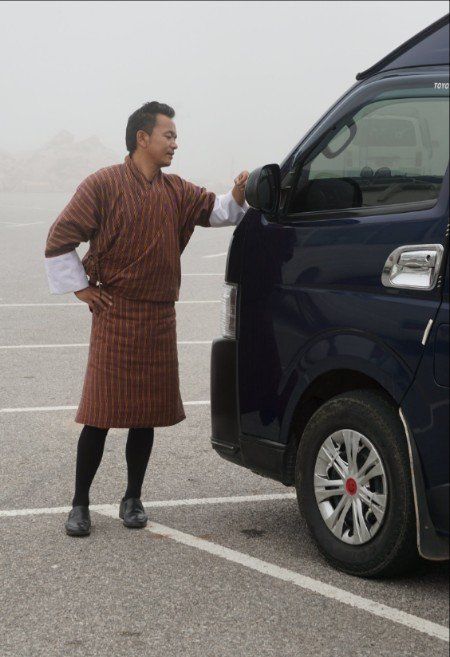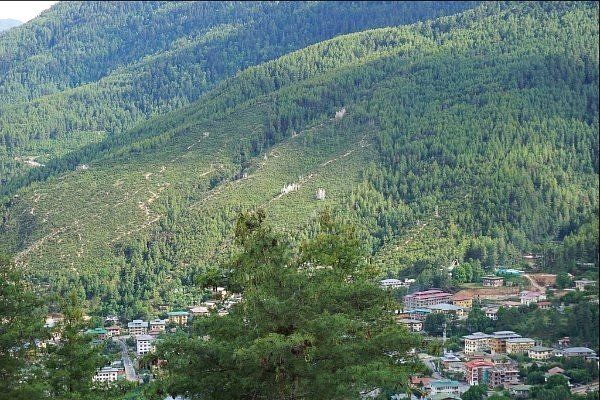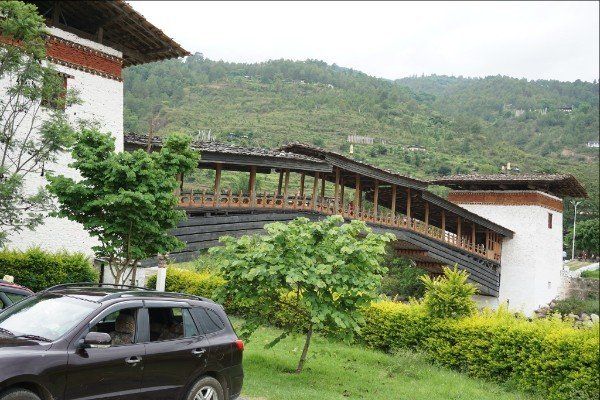Bhutan: A Land without Killing
Bhutan Culture
Buddha said, "One should not kill a living being, nor cause it to be killed, nor should one incite another to kill. Do not injure any being, either strong or weak, in the world. All beings tremble before violence. All fear death, all love life. See yourself in others. Then whom can you hurt? What harm can you do?”
Bhutan has a fascinating culture rooted in Buddhism. Its citizens take the above passage quite seriously. Cows, pigs, and sheep are never killed; this is consistent with the fact that most Bhutanese avoid eating meat -- the average annual per capita meat consumption in Bhutan is just 6 lbs (vs 265 lbs in the USA). The little meat that is consumed is imported from India; no slaughterhouses exist in Bhutan. When our Bhutanese driver or guide discovered a mosquito or fly in our car, they opened a window and shooed it out. The expression "he wouldn't hurt a fly" has real meaning in Bhutan. It is unclear to me if the practice of "no killing of animals" is written into national laws (fishing is definitely illegal) or if it has simply become standard practice among the entire population. The only widespread problem that I saw as a consequence of their "no killing" practice is that feral domestic dogs are everywhere; they walk along every road, fill every parking lot, congregate on every street corner. Not only can't the Bhutanese euthanize the dogs, but their ethics forbid them from even sterilizing them.
In a similar vein of not messing with nature, mining permits are extremely difficult to obtain. Also, although trekking is a primary tourism attraction, all treks take tourists around Himalayan peaks, never up their summits. The trash buildup problem of Mount Everest will never occur in Bhutan. The highest mountain in Bhutan is Gangkhar Puensum at 24,836' above sea level; it is the 40th highest mountain in the World, but the highest unclimbed mountain in the World.
Unique Way to Pay for Education
While on the subject of tourism, I want to share an incredibly innovative idea that the Bhutan government crafted to provide free medical care and free education through high school: they collect a flat $65/day tax from every tourist that visits Bhutan. This is the claim made to us by at least a dozen different individuals in the tourism industry. However, a little calculation convinces me that such a tax could assist
the government in providing such free services to its citizens but cannot
cover all the costs. For example, in 2017, Bhutan was visited by 71,000 international tourists, with an average stay of just under 5 days, and thus raised $22,000,000. With a population of around 800,000, Bhutan has around 100,000 students, an average student:teacher ratio of 37:1, an average annual teacher salary of $5,000, so the labor cost to provide free education in Bhutan is around $13,500,000. That is certainly within the budget generated by the tourism tax, but leaves just $8,500,000, or $10.63 per person, to cover medical care. This does not seem adequate for quality medical care.
I had hoped the numbers would work out because I was going to propose a similar model for the USA, but lets see what happens if we tried to apply it here. The United States experiences 75 million tourists per year, spending an average of 18 nights. Since they spend an average of $242 per night (seems low to me), a tourist tax of, say, $40/day should not be unacceptable. That would generate $54 billion in revenue. According to the US Department of Education, state governments spent around $600 billion and the Federal government spent around $55 billion on K-12 education in 2015. So, such a tax on tourists could at least take care of the Federal government's contribution to K-12 education. Interesting concept.
Other Interesting Facts
Because Bhutan is such a peaceful nation, it must find unique activities to keep its military disciplined and busy. Thus its Army has the responsibilities of reforestation (i.e., planting trees) and maintaining public gardens. I like this!
One of the most interesting sights when we first arrived at the Paro airport was that our guide and driver (both men) were wearing skirts called ghos. See our driver below. However, after a few days of seeing most men wearing ghos, we got used to it and didn't give it a second thought. By the way, the white cuffs called lagés are separate garments (similar to men's shirt collars of yore) and get laundered more often. Women wear ankle-length skirts called kira.

Our trip to Bhutan included drives from Paro to Thimphu to the Punakha Valley and back. The voyage from Thimphu to Punakha is spectacular; 27 km as the crow flies but 85 km (and 2.5 hours) by road over the 10,171' Dochula pass. In both directions, the pass was engulfed in clouds so we were unable to see the Himalayas, but here are photos taken at the pass.


Buddhist prayer flags appear everywhere throughout the country. They are a constant reminder to the citizenry of the values held dear. In addition, clumps of all-white flags appear on mountainsides throughout the country (see white patches above the village in the photo below); these have been erected by families of deceased individuals in their memory.

The Bhutanese have 13 traditional national arts:
- Textile Weaving (Thag-Zo)
- Basket Weaving (Tsha-Zo)
- Wood Turning (Shag-Zo)
- Painting (Lha-Zo)
- Carpentry (Shing-Zo)
- Masonry (Do-Zo)
- Carving (Par-Zo)
- Pottery (Jim-Zo)
- Bronzeware (Lug-Zo)
- Ironwork and Bridgebuilding (Gar-Zo)
- Ornamentry (Troe-Zo)
- Paper Making (De-Zo)
- Embroidery, Bootmaking and Tailoring (Tshem-Zo)

Arranging Your Own Trip to Bhutan
We have always planned our overseas trips ourselves. However that is not possible in Bhutan. The government requires all tourists to book their travel through one of 330+ officially approved tour operators (see a list of them at https://www.tourism.gov.bt/tour-operators). By law, all are required to charge you the identical daily rate, inclusive of car, driver, translator/guide, hotel, and food. The only costs not covered are souvenirs, tips and airfare. But even your airline tickets into and out of Bhutan can only be arranged through the Bhutan tour company (at an extra cost). I contacted a dozen tour operators and stated our "demands." Half of them basically said they could not meet our requests. Three said they could meet our requests but strongly recommended their standard itinerary (we were afraid to book with them for fear that once we were in their vehicle, we were virtual prisoners and they could take us anywhere they wanted). Two said they could meet all our demands except
our requests for specific kinds of hotels. And exactly one said they could meet all our demands. For hotels, we asked for accommodations well outside of cities in very quiet areas. That one tour operator was Gawaling Tours and Treks (www.gawaling.com). I became very suspicious when they sent me the final itinerary (which served as the contract); it specified the names of specific hotels (which we had found on Google maps and had previously approved of their locations) but then contained the clause "or equivalent."
It turned out that only one of the three hotels they took us to was the one they had quoted in the itinerary, and the other two were not just "equivalent," they were absolutely fabulous. All three hotels were located far from city centers, with spectacular views of mountains and dzongs. The hotels we stayed at were:
- Peaceful Resort, Upper Motithang, Thimphu
- Jangdue Eco Lodge; Punakha Valley (http://www.bhutanecolodge.com/)
- Tenzinling Resort, Paro (http://www.tenzinling.com.bt/)
Just remember, you book everything through the tour company.
© Alan M. Davis
If you enjoyed this story, consider buying my book,
Unusual Asia: Traveling on the Edge. It contains eleven other stories of our adventures in Asia.
